How Should I Care for AN Orphaned Cottontail Rabbit?
Ron Hines DVM PhD
 Portal to all of Dr. Hines’ animal health care articles
Portal to all of Dr. Hines’ animal health care articles
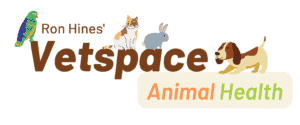

Orphaned wildlife tend to knock on the doors of kind-hearted people for assistance more than once. They seem to know. So for baby bird issues go here, opossums here, raccoons here, squirrels here and here. Turtles here. Bobcats and other such creatures are best left for professionals, but you can go here. to see how its done. The wild cottontail rabbits of North America do not require vaccinations. But that does not mean they cannot spread diseases between themselves or to you. Be clean. Isolate your food stuff from their’s, wash animal areas frequently. Chlorox is your friend, but do not expose yourself or the animals you care for to its fumes.
This spring seemed like a good time to take another look at raising baby cottontail bunnies. Of all the foundling creatures that ended up on my animal hospital doorstep, baby cottontails are the hardest for me to successfully raise. I took some time to speak to some remarkable individuals who rehabilitate large numbers of cottontails, the manufacturers of milk replacements, experts on the organisms that grass-eating animals use to process their foods and most of the veterinarians who lead in rabbit-care in the United States and Canada.
If you are reading this article because you are thinking about making a pet out of this young wild rabbit – forget that idea. In the long term, it is not going to work out for it or for you. And cuddling an animal that was born to avoid predators in the wild insures that it will not survive when you finally release it. Purchase a domestic rabbit or find one at a rescue. Most Easter bunny rabbits eventually end up there.
For another take on raising baby cottontails, read my late friend Lou Rea Kenyon’s advice. The Wayback Machine captured these two articles as they appeared on her website in 2006. Or, to read them in their combined form ask me for bunnies-Kenyon2006 pdf.
 This Is A Common Story That My Clients Tell Me:
This Is A Common Story That My Clients Tell Me:
“My husband was mowing our lawn this morning. Our dog kept sniffed at a spot near our garden. He went over and found that he had mowed over a cottontail rabbit’s nest. Some of the babies are still alive”.



 What Should You Do If Something Similar Happens To You?
What Should You Do If Something Similar Happens To You?
If you just happened to stumble on a nest, you need to understand that nursing wild mother cottontails only feed their babies intermittently during the night and for a few minutes in the early morning hours. That is the only time you will see the mother at the nest. So, you might falsely assume that the mother is neglecting her litter or that she has completely abandoned them when these babies are actually in no danger.
Also, young cottontails can live independently at a surprisingly young age. Look at the bunny in my hands in the second photograph. If the one you found is that size, it can do quite well on its own. Just be sure you and your neighbor’s cats and dogs are confined for a few weeks. Do not tame or pet this baby because it needs to remain fearful of pets and humans to survive.
Baby cottontail eyes open at 6–8 days. Mothers wean their offspring at 4–5 weeks of age. If it is over six and a half inches long from tail to nose, re-release it where it was found – the mother is still nearby. Over half the baby cottontails brought to me really didn’t need to be rescued. If the one you found doesn’t look like the one in the photograph, or you are just interested in knowing more about cottontails, please read on:
 Is This Rabbit Really An Orphan?
Is This Rabbit Really An Orphan?
Rabbits leave their nest when they are only 5 inches or so long. At this stage, they will be sniffing and nibbling at the plants around them and carrying their ears erect. They may seem too small and fragile to survive without their mothers – but they are not. If you had to run after or corner the bunny, and it appears to be uninjured, take it back where you found it. If there are too many cats and dogs there, take it to a thick brushy area at the edge of a grassy meadow and release it there.
Some people stumble on a rabbit nest and assume the babies are orphans because the mother is nowhere to be seen. As I mentioned, mother bunnies only tend to their babies from sunset to sunrise and even then, they only stay close to their babies and nurse them for short periods. If the area where you discovered them is free from immediate danger, put the bunnies back in it cover it with a light layer of dry grass and leaves, and check it the following morning for small clues that the mother visited during the night. If the babies’ tummies are plump, if you see a “milk line” through their skin, or if the string you place over the nest has been disturbed, the mother is doing her job. If the babies are cold, dehydrated, or weaker than they were the previous day, you will need to remove them if they are to survive.
 We Have Touched The Bunnies, I suppose The Mother Will Abandon Them Now?
We Have Touched The Bunnies, I suppose The Mother Will Abandon Them Now?
Thas probably will not happen. Rabbits have a very good sense of smell, but predators and humans pass through their environment every day. A momma bunny’s maternal instincts are strong, and it is not a threatening scent but a threatening presence that cottontail rabbits try to avoid.
However, if you have destroyed the high grass with a lawnmower, if your dog dug them up, or if the area surrounding the nest has been significantly changed, the mother will probably not continue to care for her babies.
 How Old Is This Little Rabbit?
How Old Is This Little Rabbit?
When cottontails are first born, they weigh in the neighborhood of 28–40 grams (1-1.4 oz), depending on the strain of cottontail and the litter size. By the time they venture out on their own, they weight 100 –130 grams (3.5- 4.6 oz).
Here Are Some Ways To Tell:
Baby’s naked or only thin fur or fluff = 1–7 days
Baby’s ears are still closed = 1–7 days
Baby’s eyes open at about 5–7 days
Baby’s ears stand erect = 9–12 days
Baby has a complete hair coat 14 days
Baby’s show interest and begin nibbling on items about = 12 -15 days
Babies become more active and begin leaving the nest to explore about 15–20 days
Baby 5–6 inches long at 17–22 days
Baby is nervous, jumpy, spooky, responds to sudden noises, ears erect = 21 days +
 Is It Hard To Successfully Raise Wild Cottontail Orphans?
Is It Hard To Successfully Raise Wild Cottontail Orphans?
Yes
Baby cottontail rabbits are the most difficult of all furry wildlife orphans to successfully raise or rehabilitate.
Wild bunnies have the same basic needs and medical problems that domestic rabbits do. However, the conditions in which they survive and thrive are much narrower than that of domestic rabbits. Like all wild prey animals, cottontail rabbits are very easy to fatally overstress. They mature much faster than domestic rabbits and when they go down hill, they do so very quickly and rarely give you time to correct the problem that caused it.
Successfully raising these bunnies is a major commitment in time and dedication. You can’t rush it, you can’t work it into your schedule around other commitments – like kids and work hours. Some people seem to naturally have this nurturing talent while others who love wildlife just as much do not. Some people are just too giving and over-feed these babies. Those people can do more by just offering support to others that are more successful at it.
People who raise orphan cottontail rabbits often loose them in three ways:




 Is There A Best Way To Hand-rear Baby Cottontails?
Is There A Best Way To Hand-rear Baby Cottontails?
No.
What works best for someone else may not work best for you. There are as many techniques, ideas and variations in raising infant cottontails as there are people doing it. And everyone naturally thinks their way is the best way. They can be quite adamant about that. But just like the roads in your City, there are usually several good ways to get to your desired destination. Some roads that are bumpy, others are dead ends others dangerous. This pertains particularly to milk formulas and feeding schedules you use. I can tell you the ones that I know work well. But that doesn’t mean there are not others and it doesn’t mean that what works for another person will work for you.

Yes
There are probably plenty of these laws where you live. Unknown to many kind hearted people, wildlife officials do not care about the fate of any single, orphaned cottontail rabbit – or entire litter. These are wildlife management folks. They design laws to “mange” a “natural resource” like coal or oil. They see cottontails as a resource to be “harvested” during rabbit season and as a food resource for carnivorous wildlife year round. It would be very difficult for them to design laws that made exceptions for the baby cottontail that you just found. Their usual respons is “let Nature take its course put it back where you found it”. Or, if you live in the RGV, give you my telephone number.
As a tidbit to public opinion and to improve their image among the non-hunting public, state wildlife agencies make an exception for people like me. The Feds are less generous, I have to actually pay the USFWS in Albuquerque New Mexico for the “privilege” of rehabilitating wildlife they drop off. How I finance that is my problem. Reems of paperwork that is never read by any of them accompaines that “privilege”.
It is true that people who make a career out of raising orphan wildlife tend to get better at it with time. They apprentice with others, take training courses, get continuing education credits and read up on the subject. Some will have better success rates than you an inexperienced person will – even if you follow their or my advice. Over the years, they learned to handle the discovery of a dead bunny in its cage better than most of you will. I am not going to get in to what you should or should not do with demands of the wildlife bureaucracy – that’s for you to decide. (read here)

 How Much Human Contact Should This Bunny Have?
How Much Human Contact Should This Bunny Have?
That depends on where and how soon you plan to release it. There are two conflicting processes working here. The first is that baby bunnies are calmer, easier to feed and less stressed when they are comfortable with the touch and presence of the person who feeds and cares for them. Initially, bunnies may seem tame and accepting of handling when they are actually terrified and frozen with fear. The older the baby is when it is found, the more likely this reaction. If the baby you found is capable of feeding itself entirely on plants, minimize your contact with it. That way, it will be more likely to survive when you do release it. If it is younger, with repeated handling and caressing it will calm down, relax and thrive. But its trusting nature will be a disability to its survival when you are no longer there to protect it. I know of no easy solutions to this. Bunnies that no longer have a normal fear responses need to be released in locations where they are protected from humans, pets and predators if they are to survive. There is an element of this problem in all bunnies that are hand raised, but it will be worse in those that have the most human contact. However, some bunny rehabilitators have found that those with the most human contact thrive the best. An alternative is to release trusting bunnies in stages, moving them to larger and larger pens and visiting them less and less, until their natural spookiness returns. Fear is genetically hardwired into wild rabbits. With time, it will return if given the chance.
 At What Temperature Should I Keep This Baby?
At What Temperature Should I Keep This Baby?
Buy an aquarium thermometer or chick hatchery thermometer at a pet supply house or feed store. The bunny’s environment should be cozily warm, but not hot. The body temperature of adult cottontails is about 101.5 – 102.5F/38.6-39C. Babies run a degree or two cooler. If room temperature is kept at 78-80F/25.6-26.7C, furred bunnies usually remain warm by just snuggling down in their nest, particularly if there is more than one. Smaller younger bunnies chilled bunnies and bunnies maintained at colder temperatures need supplemental heat. Their smaller bodies lose heat more rapidly and their sparce haircoat compounds the problem. An ordinary heating pad, on its lowest setting, placed under 1/3 –1/2 of the primary box they are in should be sufficient. Too hot an environment is as damaging as one that is too cold. A hot water bottle is the safest option. But it is time consuming to set up and maintain. Check the rabbits environmental temperature frequently. Smaller, babies without complete fur really need an improvised incubator to keep them at the proper temperature just as human preemies do. These can be improvised using a low wattage light bulb. But you need to get it to a constant temperature before the bunnies are put near it.
 What Are Some Of The Main Reasons Baby Bunnies Do Not Survive? (Stress Of Neglect, Predator Trauma, Chilling, Dehydration, etc.)
What Are Some Of The Main Reasons Baby Bunnies Do Not Survive? (Stress Of Neglect, Predator Trauma, Chilling, Dehydration, etc.)
I mentioned all of these thing earlier. Sometimes, too much time passed and too many stressful things happened to this baby before it came to you. Stress damages many organs and some stress-related organ damage irreversaible. On hot days, baby rabbits can dehydrate rapidly. Once dehydration is severe enough, giving fluids orally is no longer curative. Sterile fluid like PSS needs to be given subcutaneously by injection.

Unseasonably cold or rainy weather is tough on baby rabbits. Some will leave the nest too early and may be beyond recovery when they are found.
 Early Mortality Due To Lack Of Colostrum And Natural Milk Factors It Contains
Early Mortality Due To Lack Of Colostrum And Natural Milk Factors It Contains
I also mention this earlier. Health problems and mortality due a lack of colostrum are particularly a problem in babies that are under 2 weeks of age when they arrive. Cottontail mother’s milk has protective ingredients (“antimicrobial fatty acids”) that artificial milk replacements cannot duplicate. (ask me for bunnies-cole.pdf) Others call these ingredients “stomach oils”. Their first milk (colostrum) is very rich in an active form of vitamin A called retinol – something not found in replacement formulas but essential for normal development. Baby bunnies receive protective antibodies from their mothers while they are still in the womb. But during the next 10–12 days of their lives, this antibody is lost. Mother rabbit milk also contains these same antibodies (immunoglobulins) that help protect the baby during its first 12 days. Hand-raised bunnies are at a major disadvantage in not receiving them in that they are more susceptible to infections. Antibiotics are not a solution to this problem. They may prolong the baby’s survival by a few days, but they cause more harm than good by destroying the protective good bacteria along with the bad.
 Should I Add Lactobacillus (Probiotics)?
Should I Add Lactobacillus (Probiotics)?
Healthy baby rabbits do not naturally have lactobacillus bacteria in their intestinal tract or stomach, and it is unknown if any of these bacteria can actually survive the high acid content of the baby rabbit stomach. But that doesn’t mean that lactobacillus and other probiotics bacteria might not help protect them from dangerous bacteria during their first 2–3 weeks of life. In the lab, these bacteria are known to protect rabbits from the toxic effects of certain bacteria, and they seem to protect other rodent relatives under stress. They promote the formation of an acid (lactic acid) environment which might help prevent harmful bacteria from flourishing. Some bunny rehabbers feel that probiotics do help somewhat in preventing intestinal disorders. The products they commonly use are PetAg’s Bene-Bac™, Fox Valley’s Formula LA200 or human Flora Smart in dried or past culture. But a greater number of folks find that giving natural rabbit cecotrophes beginning when the baby is 3 days old works better. Cecotrophes are the soft night stool of rabbits. When given, a pea-size amount is sufficient. Place it in the bunny’s mouth rather than mixing it with its formula. Whether or not you give the baby probiotics, giving cecotrophes may be essential to the bunny’s survival. You may find that process “yucky” but human physicians are just now learning how important a proper digestiver tract flora are to good health. Probiotics products are not a substitute for seeding the baby cottontail with its normal bacteria as quickly as you can. I do not give both cecotrophes and lactobacillus/bifidobacter cultures simultaneously because Lactobacillus promotes an acid environment, in which cecotrophic organisms do not thrive. In rodents, it takes a minimum of 59 separate organism strains before the physiology of their digestive tract remains normal. A total of 55 different organisms of this type were found to naturally live in cottontails. (read here)
 Bunnies Lost Due To Improper Formulas
Bunnies Lost Due To Improper Formulas
There is no end to the curious things people attempt to feed baby cottontails. The usual thing that does them in is feeding cows milk. It is not the lactose in cow’s milk that is the problem, the lactose level of goat milk formula is higher. The problem with cow’s milk is that it is too dilute in nutrients to sustain baby cottontails. Other than cow’s milk, things like honey apple sauce and sugary fruit additions are really not things baby bunnies are equipped to digest.
 Bunnies Lost Due To Overfeeding
Bunnies Lost Due To Overfeeding
This is the biggest problems for me when feeding baby cottontails. It is just hard for people like me with a soft spot for baby critters to stop feeding a cute bunny. The rule of thumb is to stop feeding the moment the bunny does not accept its formula greedily or the moment its tummy becomes slightly rounded. Feeding 1-3 week old baby rabbits too infrequently (only 1–3 times a day) also encourages them to over-nurse. Over-distending the poor infant’s stomach is also a problem when formulas are too dilute – such as straight goat’s milk or canned KMR. Remember, real cottontail milk is very thick and rich – 33% solids! . Some people say these bunnies die of “bloat” – which is sort true. But it was milk bloat, not gaseous bloat.
Mortality Due To Dysbiosis (=the wrong or missing intestinal bacteria and fellow microbes)
People who raise orphan cottontail rabbits know all about this problem even if they do not use the word, dysbiosis. They get in 1-2 week old baby bunnies that look great. The rabbits nurse well, grow well, and then suddenly drop dead. They may look fine in the morning, a bit apathetic at noon, and gone a few hours later with only a few terminal signs. Occasionally, they have diarrhea, but most do not. Some also call this “bloat” but that is not what really happened. Others call it acute enterotoxemia or acute mucoid enteropathy, which is truer. Here is what is really happening – it is a long and complicated story: When cottontail rabbits are born, there are no bacteria in their digestive systems. Dysbiosis is a fancy word for the wrong intestinal tract bacteria. If the right ones are not provided (by you), the wrong ones will inevitably take over. They are on your hands, in your breath (read here) on your utensils, in the air ducts, etc. Your human-raised baby bunny does not have a natural source of these important protective organisms. In the wild, it would have received them from its mother as she groomed it and as they would have been contaminated by or ingested her stools.
 How Do I Prevent These Common Digestive Problems?
How Do I Prevent These Common Digestive Problems?
You will have to bring these important organisms to the bunny yourself. You are its momma now and that’s your job. If you aren’t up to it, give the rabbit to someone who is. Wear disposable gloves. Cottontail and other rabbits produce two types of feces, the first-pass feces that I mentioned called cecotrophes (aka “night soil” or night stool) and ordinary bead-like, roly-poly daytime rabbit droppings. The microscopic critters you need are in their highest concentration in the nightime cecotrophes. Since the exact beneficial role of each of these organism is unknown, you need to supply all the types that are present. I am sure a few types survive in ordinary rabbit droppings – but not all of them do and not in sufficient quantity. Some are killed by the oxygen in the air. (read here) Some are fairly stable, others are very delicate. Some survive up to 14 days at 40F/4.4C in the fridge, other types last less than a day. At 95 F/35 C, many types only survive 1–12 hours.
More About Cecotrophes – How Can I Tell Them From Ordinary Stool?
We all know what regular rabbit poop looks like. But the kind you need is different. Rabbits produce this form mostly at night. It is dark, sticky and clumpy and it smells. It is much softer than daytime stool. Most people, who have successfully raised orphan cottontails, get this material from a healthy mature domestic rabbit. Don’t look for one at the feed store or pet shop. You need a healthy, well-adjusted, domestic rabbit that has been eating a primarily hay for a considerable period of time. Check with your local 4-H or FFA. Pet domestic rabbits that are being fed too rich a diet do not make good donors. Nor do rabbits eating the high protein rabbit pellets designed to feed rabbits destined for slaughter.
In the morning, you can often find a few cecotrophes that have dropped through the domestic rabbit’s wire cage floor or in corners and nooks in the rabbit’s cage. (it is not a good idea to keep rabbits on wire, it eventually causes foot problems – but that’s a different story). One can also put a rabbit in an Elizabethan collar to keep it from eating its cecotrophes passed the previous night. Be sure there is new paper under the cage. Slope the floor to prevent urine from contaminating the material.
Feeding one cecotrophes to the baby cottontail a day is sufficient (less to smaller babies). Many are soft and gooey enough for you to just place it in the infant’s mouth and let him/her swallow it. It is better to give a small amount of this material on many days than it is to give a large amount only a few times. If conditions are right within the rabbit, the organisms in the cecotrophes will proliferate and flourish in the bunny’s cecum. If conditions are not yet right, whatever amount you give will not flourish. Some people liquify the cecotrophes, so they can feed it with a syringe. That’s probably OK if you mix it with a thick rabbit formula, not chlorinated tap water. Many of these organisms need the buffers in milk to survive. Cecotrophes also contribute important enzymes that help a rabbit digest its food. Although some mix the cecotrope with the rabbits milk formula, I prefer not to do that because it breaks down the mucus that is protects these fecal organisms from the strong acids in a bunny’s stomach. (read here) Continue to give cecotrophes 2–3 times a week until the bunny is weaned. When these organisms will all take hold and flourish depends on the changing acidity of the bunny’s digestive tract as it matures, the food being fed and the “pioneer” organisms that have already established themselves there. Some rehabbers have success refrigerating cecotrophes material and using it later. But I doubt that the entire population that was initially present survives long in the fridge. Some of the organisms are more stable than others. Perhaps they are all that will be needed. We do not know. Even home freezer temperatures do not preserve some of these bacteria. And none of the normal protozoa survive freezing. (I have used products called cryoprotectives to freeze some of these organisms in liquid nitrogen when I had unlimited resources to do so at the NIH.) (read here) Do not allow your cottontails to nibble on plant material (hay, grass, etc.) before you have begun them on cecotrophes. The plant material will simply rot in their cecum if they do not have the cecotrophic bacteria to help them digest it.
 Does This Orphan Need Veterinary Or Emergency Care?
Does This Orphan Need Veterinary Or Emergency Care?
Cottontails are delicate creatures easily injured when they have been caught by pets. When it was a house cat that caught the rabbit, the damage done by small tooth penetrations can be unapparent to you – but still fatal. The mouth of cats carry many bacteria. A common cuprit is pasteurella. (read here) I mentioned earlier that antibiotics that kill bacteria like pasteurella also kill of the bacteria that rabbits relies on to digest their food. Many young cottontails brought to me were run over by lawnmowers. Those bunnies need immediate, specialized veterinary care. Only a few veterinarians have the knowlege to do that. Contact a local rabbit club and ask who treats their rabbits. I mentioned that cottontails and rabbits in general do not handle antibiotics well. When they must receive antibiotics, only certain ones (e.g. Bactrim®/Septra®) can be used successfully. The “good” bacteria and other flora of their digestive systems needs to be replaced when the antibiotics are no longer in their system.
Check the baby thoroughly for any evidence of limping, wounds, blood, missing fur, abnormally low body temperature, erratic breathing, or dehydration. Ear mites can make rabbits quite miserable. They are common in domestic rabbits but I have never encountered ear mites in wild rabbits. Perhaps other have.
Baby cottontails that have been abandoned for more than a day often come in dehydrated. When the skin at the nape (base) of the neck is pinched, it will spring back slower if the baby is dehydrated. Mild dehydration can be treated with oral fluids (Pedialyte™). But severely dehydrated bunnies will no longer absorb fluids given orally. Those rabbits need subcutaneous injections of fluid (ringer’s solution, etc.). If you are reading this article and not a wildlife health care professional – that is something you should not attempt.
One big advantage that seasoned wild rabbit rehabilitators have over you is that from their past sad experiences, they often recognize the signs of gastrointestinal problems sooner than you would. Sick baby bunnies go downhill lightening-fast. From the first sign that something is amiss to the death of the baby can be as short as an hour. In handling baby bunnies for the first time, remember they jump like springs and are easily injured when they are dropped. Always use your second hand as a lid over the one holding the bunny.
Low body temperature is very dangerous. The baby should not feel cold in your hand. Its gum color should be bright pink – not bluish. Its nose should be of a uniform color with no crusts. It should wiggle its nose. The best way to emergency warm baby bunnies it is with a heated towels or a blow-dryer as you carefully shield frome baby with your hands. Driers designed for pets produce a higher volume of air at a lower temperature than human hair dryers do. So be cautious. I prefer warmed dry blowe-heated towels to pack that around the rabbit. The sound of blow driers is noisy and stressful. Once it is warm, wrap it in a cotton sock or washcloth and place it on a hot water bottle. Give nothing by mouth until its body temperature feels warm and then just a drop or two of warmed Pedialyte™. Any bluish color is a very worrisome sign.
How Fast Should This Bunny Grow?
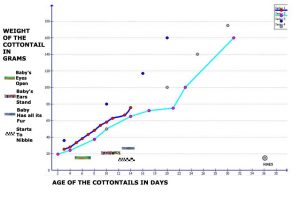
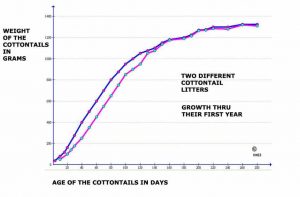
Weigh the bunny every day at the same time and jot its weight down in a notebook. Ideally, it should gain weight every day throughout the period you care for it. Some days it will gain more weight than others. But a period of 2 days of flat weight or any loss of weight is not a good sign.
These are average growth curves for wild, mother-raised baby cottontails. They are not going to exactly match the growth curve of your cottontail because the cottontails that live in your area may be larger or smaller, their litter size influences their growth rate, and the formula and amount you feed are not going to match that provided by their mother. Your rabbit will do fine even when it is above or below the general curve. But the shape of the curve you plot should generally match the shape of the curve I have provided. There is as much danger in a bunny growing too fast as there is in one growing too slow.
Cottontail rabbits reach about 90% of their adult body weight 125 days from birth. Their most rapid growth is in their first 60 days. At birth, they weigh from 28 to 40 grams. They wean at about 118 grams. Their final adult body weight is about 1,150 grams.
 What Should I Feed This Baby Cottontail Rabbit?
What Should I Feed This Baby Cottontail Rabbit?
Milk based formulas for wild cottontails have always been a source of confusion and contention.
The first reason is that there are so many independent bunny rehabbers in the US who do not coordinate their efforts or are reluctant to share their information.
The exact nutritional needs of baby livestock, dogs, cats and humans have been known for a century. Human infant nutrition has been thoroughly studied and pet food and agricultural companies paided the bill for the rest. But when it comes to the nutritional requirements of orphan cottontails, we have very little data to go on. Things generally don’t get done in the US unless there is some financial reward for doing them.
The second is that there are so many factors, other than formula, that can lead to baby bunny death or failure to thrive. It is always easiest to blame formula constituents for limited success or attribute success to some “magical” ingredient.
The third is that all replacement formulas, goat’s milk included, vary from batch to batch and none of them perform as well as real rabbit milk. (read here) All powdered and pre-diluted infant animal formulas consist of multiple batches of natural raw ingredients purchased from commodities brokers. There is a limit to how many batches of raw ingredients can be sent out for testing and the company still sell their products at a profit. These are all small companies with limitted resources. Wild cottontail rabbits feed their babies milk that is exceedingly rich. It is about four times as high in protein and fat as cow’s milk and is much richer than cow’s milk in many vitamins.
Many people who successfully raise orphan baby cottontail rabbits in the United States use a formula made from a combination of powdered KMR (kitten milk replacement) and another product called Zoologic 30/55® (aka Multi Milk®). Generally, they are mixed 1 part KMR, 1½ parts Zoologic 30/55/Multi Milk and 2 parts of warm, previously boiled water. This gives a consistency that at about twice as thick as the mixing directions on the label. It must be fully dissolved and smooth – never lumpy or gritty, and it should not settle to the bottom.
These products are made by PetAg. Similar products are manufactured by Fox Valley. Many get equally good results with Zoologic 33/40 mixed with Multi-milk. PetAg was spun off from Borden’s years ago when the employees offered to take over their facility rather see it shut down. As, of the writing, it is a small, privately owned company. If you live outside of North America, you can try to obtain one of the Wombaroo product lines. All commercial powdered milk formulas are complex recipes, having quite limited shelf life and rely on ingredients that can vary from batch to batch. Do not feed any batches that are lumpy, smell rancid, have been stored in hot environments or are reaching their expiration dates. Refrigerate the containers as soon as you purchase them. Their dry commercial formulas have varied from batch to batch, and they also have a reputation for a short shelf life. The problem with feeding formulas based on only powdered KMR is that no matter how you dilute it, it will not match the fat or carbohydrate content of cottontail rabbit milk. That is why some rehabbers use powdered Esbilac instead or add heavy whipping cream. Never use a sweetened cream.
There are only a few suppliers of the Zoologic line in the US. In a pinch, some prepare a formula consisting of 1 part heavy whipping cream can be added to 3 parts powdered KMR and 3-4 parts water until you can get your hands on a can of Zoologic, UPS overnight.
If any of these formulas cause diarrhea, try feeding it more diluted with Pedialyte™, in smaller amounts and at an increased frequency. It is not so much that diluteness lessens diarrhea, but it does replace the fluids lost to diarrhea.
KMR and Esbilac are also sold premixed in cans. They are not suitable for use in feeding rabbits. Their biggest drawback is that they are too dilute out of the can. Baby rabbits would have real problems drinking enough to meet their nutritional needs. But even their diluted nutrient analysis is too dissimilar from cottontail milk to sustain baby rabbits for very long. If you would like to read a letter from a successful cottontail rescuer in Ohio regarding her techniques, ask me for bunnies-RehabierOhio.pdf.
Goat Milk Formulas:
For over 30 years we have known that rabbits can be successfully raised on formulas based on goat milk. I have no experience doing so. Ordinary goat’s milk is, too dilute in nutrients to sustain cottontails when fed in normal amounts. But it is sold by Meyenberg in a more concentrated powdered and an evaporated form that can be the basis of cottontail formulas.
 At What Temperature Should I Feed These Formulas?
At What Temperature Should I Feed These Formulas?
The formula should be warm to the touch but not too hot – the same temperature that you would choose for a baby human infant. Microwaving formula can cause hot-spots that scald the baby, and repeated microwaving or freezing and thawing destroys vitamins. Just run hot water into a pan and drop the syringe into that until it comes to temperature.
 How Should I Give The Milk?
How Should I Give The Milk?
I prefer a 1cc tuberculin syringe with removable needle. Your veterinarian should have some. Use and re-boil them between feedings until they no longer hold vacuum. As the babies grow, switch to a 3ml syringe. Ask for syringes that are not “luer lock”. If none are available, it is best to remove the needle locking mechanism from the tip with snips. For very small or weak bunnies, I place a 22Gu soft intravenous catheter on the tip. Some rehabilitators prefer a rigid stainless-steel feeding tip. A pet nursing bottle can be used for the largest babies – but only if they are bright and chipper. Squeeze pipettes also work well – you can draw out the tip when it is softened over a cigarette lighter. Teat cannulas can also be used for tips. Here is a photo of some of the supplies I find useful:
Bunnies like to take their time nursing. That is fine when you have one or two babies – never rush them. But nurturing baby cottontails that way consumes too much time when rehabilitators are drowning in rabbits. In those cases, the babies can be feed more rapidly and safely with a gastric tube. Do not attempt this without instruction – it is very easy to deliver too much milk, causing pneumonia or suffocation.
However you feed, do not depress the plunger of the syringe any faster than the baby swallows. When you coax it, most cottontails will lick or lap up the drop of milk on the end of the syringe. Advance the plunger down slowly as need be. You will need to actually put the end of the syringe in the mouth of small babies that still have their eyes closed. (of course, without the needle).
 How Much Formula Should I Feed?
How Much Formula Should I Feed?
You will find many different suggested feeding amounts. That is because the amount that needs to be given will vary considerably depending on the richness of the formula you feed and the frequency at which you offer it. Rather than follow those guides, feed your bunny as long as it greedily accepts the formula and stop when it doesn’t. Never continue to encourage them to swallow when they are no longer enthusiastic about it.
Feed the baby until its stomach has filled out but is not so much that it becomes firm, taunt or hard. When in doubt, feed less but feed more frequently until you are confident the cottontail is thriving. If it is steadily gaining weight, you are doing fine,
I know of rehabbers who do fine giving approximately 10% of the bunny’s weight (grams=cc=ml) 3 times a day up to a maximum of 6 cc, weighing them at every feeding. Once they are nibbling, they feed less or skip feeding if their weight gain was sufficient during the day.
 How Often Should I Feed?
How Often Should I Feed?
I feed cottontail babies every 2–3 hours during my waking hours until their eyes open. There is no need to try to duplicate their natural twilight and nighttime feedings. Then I gradually reduce my feedings to every 3–4 hours during their 2nd to 4th week. If the babies do not appear to be hungry, I try again a few hours later. Feeding less frequently decreases the rehabilitators work load, but it greatly increases the chance that the baby will accept a greater volume of formula than is healthy for it. Check the baby’s weight regularly for slow steady growth. If they aren’t steadily gaining weight on a balanced formula, feed them more frequently or increase the concentration of the formula. When you first begin feeding the bunny, feed the formula very dilute (1/3 formula, 2/3 Pedialyte™) the first few times. At this stage, what the rabbit needs is the fluids in the milk to combat any dehydration it may have suffered, and it needs to become accustomed slowly to the ingredients in its formula it is not used to. Your formula is not going to be identical to what it was drinking in the wild. If the baby is not alert, if it is limp or weak or if it is cold – these initial fluids need to be given subcutaneously by injection – not by mouth. They need to be administered by someone who knows what he/she is doing.
 How Should I Hold The Bunny While I Feed It?
How Should I Hold The Bunny While I Feed It?
I try to hold the babies in a position I imagine they would suckle if they were feeding on their mom. I do not hold them upside down on their backs because I feel they are more likely to aspirate the milk in that position. Tilt their head slightly higher than their posterior and hold them firmly, but not so tight as to make it difficult for them to suck or breath. Wrap them loosely, like a burrito, in a soft sock or section of cloth to sop up the drips and give them a sense of security. If you are uncertain if a newly arrived bunny will bolt or jump, feed it sitting close to the floor. New arrivals will often jump suddenly when you least expect it. Even rabbits that have been with you for some time need to be supported firmly to prevent them from injuring their legs and spines.
 Some Other Feeding Tips:
Some Other Feeding Tips:
Drinking from a syringe must seem very odd to the bunny at first. It is used to sucking on a warm, soft nipple. There is medical grade, Silastic™ (silicone rubber tubing) that I sometimes threaded over the syringe tip to give it a soft, natural like feel. Just be sure the bunny does not swallow this tubing. Keep a box of Kleenex handy to pat dry the baby’s nose as it nurses before milk can pass up its nose. Do not save left over milk from earlier feedings. Try to avoid contaminating your reconstituted refrigerated supply as little as possible. When in doubt as to freshness throw it away. Feeding multiple litters from the same container is to be avoided. These formulas tend to settle to the bottom on standing. Stir them well before you use them. I find it easiest to get the syringe tip into the bunny’s mouth from the side and then slowly move it to the front as the rabbit feeds. The lips to the rear form a natural pool that allows the rabbit to get a small a taste of the formula before it associates the syringe with mealtime.
 Hygiene
Hygiene
It is important to be sanitary when feeding a wild bunny. These cottontails have all been stressed, and stress lowers immunity to infection. They are also more susceptible to infection because they are not receiving their mother’s antibodies in the milk substitute you are providing. I prefer boiling, microwaving and baking to destroy bacteria over the use of bleach and other antiseptic products. If you have to use an antiseptic cleaner, use ordinary 70% grain alcohol. Many rubbing alcohols have nasty bittering agents added to them to keep people from consuming them. Hygiene becomes particularly important when large numbers of bunnies are being fed and cared for. This is because in large groups, there is always one or two that are ill, and you do not want those illnesses to spread. Wash your hands between animals, feed rabbits before other wildlife and feed the weaker ones and new arrivals last. It is unwise to keep large numbers of bunnies in close proximity to other wildlife or pets. When animals live crowded or in close proximity, disease organisms in one, eventually move to all the others despite your precautions. I also prefer that one individual take total care of a specific animal and I encourage them to do that at their own home. Once old enough to be eating on their own, don’t change the liners on bunny cages too frequently as the rabbits need to eat their fecal pellets.
 Stimulating The Baby To Poop And Pee
Stimulating The Baby To Poop And Pee
This is only necessary for bunnies whose eyes have not yet opened and those that are not moving about on their own. After feeding, use a moistened Q-tip to gently stroke their genital area. Don’t be concerned if they do not always respond as long as their tummies do not become bloated. If you place white paper towels on the bottom of their box, you will see the yellow stains that show that they have begun urinating on their own. Be gentle.
 When Should I Begin Solid Foods, And What Should I Feed?
When Should I Begin Solid Foods, And What Should I Feed?
My observation is that you won’t improve on how God manages His creatures here on Earth. You don’t see wild cottontails munching on apples, digging up carrots, chewing on corn or visiting health food stores. And the ones that don’t have access to homeopathic formulas and new-age medicine do just fine. If you want healthy wild bunnies, feed them what they were designed to eat.
When cottontails begin to become curious about the taste of things around them, give them the plants they would normally encounter and for which they were designed. Pick a variety of these wild grassland plants and hays and offer them to the rabbit.
I know that will be a lot more work for you than just picking stuff up at your supermarket. But it will increase the bunny’s chances of survival once it is on its own. Soon after the cottontail’s eyes have opened, they venture near their nest with curiosity, I keep hay and plants in their cages. By then the rabbits should have received sufficient cecotrophes from you to digest plants. Try to pick young tender leaves, buds and new growth and don’t pick along polluted roadways. Observe what wild cottontails are browsing on in your area and include plenty of that as well. Plants are most nutritious when they are still growing. So pick in irrigated areas and select tender buds, shoots and new growth.Farther south in the USA, St. Augustine grass and hibiscus flowers are fine to include. You are always much safer feeding a large variety of plants, not just one or two. You can supplement wild diet with supermarket- bought greens: endive, kale, romaine lettuce, watercress, turnip tops, chard, etc. Try to obtain the outer leaves the staff throws away. Supermarkets have always been more than willing to donate those products to me. I don’t wash or disinfect the wild plants I gather. The microscopic organisms that are naturally on them are particularly important if you are uncertain that the bunny received adequate cecotrophes. As soon as the rabbits begin to consuming or nibble on these plants, I eliminate my noon formula feeding and begin to lessen the amount given in the AM and PM feedings. The stomach and intestinal conditions and bacteria required to digest plants are different from those necessary to digest formula. You can’t have both types of bacteria happy at the same time. That is why I do not use powdered formula or supplements as a top dressing. By 3–4 weeks, they should no longer need to be receiving formula. Formulas are “unfriendly” to the bacteria that normally begin to colonize rabbits at that age.
 Should I Offer The Bunny Water At This Time?
Should I Offer The Bunny Water At This Time?
Yes
Once the bunnies are out and about in their cage, I add a small crock of water. Jar lids are fine if you fill them with marbles. At this stage in their life, they are getting plenty of liquid through their formula, but I want the security of knowing it’s there if they want it. Sipper tub bottles are OK as well, as long as you are certain it is working as it should and that the rabbit understands how to use it. Coat the end of the sipper tube with molasses or peanut butter until you are certain it does.
 Pre-release Caging
Pre-release Caging
I construct my cages using pine framing and 1/2 inch hardware cloth, but there are many good alternatives. I have found that a 48”x 36” x 18” cage is sufficient as a pre-release cage for 3–4 rabbits, but you could construct them considerably larger. The top of the cage is hinged for access. You can use larger mesh, but I prefer this size because the cages are stiffer, and they keep out mice. I wash new cages with a vinegar solution before use. Do not use pressure treated or painted lumber. I place the cages at eye-level to deal with my backaches, but wild rabbits don’t appreciate people peering down at them. Keeping a layer of dry hay on the floor of the cages keeps the bunny’s tender feet from becoming sore. Change it often. Add some cardboard shoe boxes for it to hide in and some fruit-tree branches to nibble on. If these cages are out-of-doors, they need a piece of sheet tin as a roof and placement to avoid the heat of the day. Other than that, use your imagination. Both raccoon and opossum feces carry parasites that can be fatal to rabbits. Arrange your cages, so no critters can climb over the cages at night or contaminate their future supplies. This is a time when I let their natural fearful instincts and distrust of humans blossom. I place their cage where there isn’t much human traffic and only approach to service and check on them. Some bunnies become spooky and ready for release earlier than others.
 When Should I Release This Bunny?
When Should I Release This Bunny?
People feeding bunnies without cecotrophes often release them early (less than 5 weeks). That is one way to improve release statistics when providing deficient diets and a less than sufficient environment. It is also tempting when rehabbers are overwhelmed with mouths to feed. But I doubt that many of these rabbits survive.
Any hand-raised cottontail is going to be at a disadvantage when dealing with predators and dangerous situations. If you have personally raised this cottontail, you will instinctively know when the time is right. It should be alert when you are present, hunker down when confronted with sudden movements or people looming over it. It should be afraid of dogs. It should tense up or vocalize when you grab it. Cottontails often rear up on their rear legs about now – and they may show the beginnings of aggressive behavior to their cage mates – or you.
Check the long-term weather forecast for periods of good weather. I release them just before sunset.
If you deal with enough baby cottontails, there will always be a few “special needs’ bunnies that you know will never be able to adapt to truly wild living. Use your ingenuity with those – every one is different.
 Where Should I Release The Bunny?
Where Should I Release The Bunny?
That is a dilemma that all wildlife rehabilitators face. If an area already has rabbits, it probably has all the rabbits that the plant-life there can support. If it has no rabbits, there is a good reason for that also. Either, there are not enough edible plants, there are too many predators or the area is being hunted. Your bunny already comes with a big disability – it isn’t as spooky as it should be about threats and dangers, and it will be potential finger-food for every predator in the area. Besides, God only destined that a very small percentage of young-of-the-year survive until the following spring.
Young cottontail rabbits hang out in relatively small areas of only an acre or two. In town, I find fenced drainage easements, fenced power plants, large city parks, museum lawns, churchyards and cemeteries best, as long as they also have some brushy areas in which to hide. Some of these areas are too cut off from wild rabbit populations to allow rabbits to have made their way there, but still have plenty of plant browse and no predators. Parks that allow pets are not good places. Nor are places close to busy roadways. The tamer an animal is, the farther away from humans I try to release it. Big country estates will often agree to let you release bunnies there. Closed military reservations are fine. So are airport clear zones if they do not have a “hazardous wildlife program” in place. Once you find a good release area, it is tempting to release too many bunnies there. If you get heavy into rabbit rehab, potential release sites will always be at the back of your mind when you are driving.
Tracts of land with “for sale” signs are not good locations, bottom land and field borders on established farms are. If you can conveniently stroll through the area without getting poked and thorned, the brush isn’t dense enough. Bunnies are particularly fond of brush piles. They are easy to build – the thornier and denser the better.
Look for established family farmers. I generally chew the fat with the farmer to casually inquire if they hunt bunnies or lease out hunting rights before I bring the subject up. Bring them some thank-you baked goods from time to time.
 I Have Become So Attached To This Rabbit. I Would Hate For It To Be Eatan By Some Predator. Should I Keep This Adorable Creature As My Pet?
I Have Become So Attached To This Rabbit. I Would Hate For It To Be Eatan By Some Predator. Should I Keep This Adorable Creature As My Pet?
No. Buy a domestic rabbit. It has been my experience that with time, these rabbits become spooky and many, when startled, will break their spines. You gave this one a helping hand when it needed it. Now send it on its way and let it become what God intended it to be. And remember that it is not the destiny of more than a few infant bunnies to survive to maturity. If that was not the case, the world would be overrun with rabbits.
Dear reader, Besides your donations, visitors to the products that Google and others display on my website help me defray the cost of keeping my articles on the Web – and you informed. As you know, sites like mine that intentionally use no AI, no SEO, and are not written to Sell You Things are getting harder and harder to find, Best wishes, Ron Hines

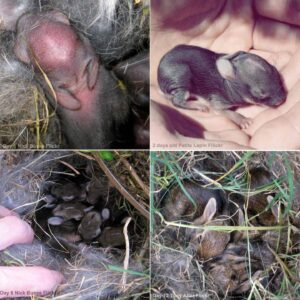
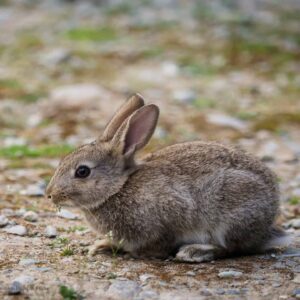
 This Is A Common Story That My Clients Tell Me:
This Is A Common Story That My Clients Tell Me: What Should You Do If Something Similar Happens To You?
What Should You Do If Something Similar Happens To You? Is This Rabbit Really An Orphan?
Is This Rabbit Really An Orphan? We Have Touched The Bunnies, I suppose The Mother Will Abandon Them Now?
We Have Touched The Bunnies, I suppose The Mother Will Abandon Them Now? Is It Hard To Successfully Raise Wild Cottontail Orphans?
Is It Hard To Successfully Raise Wild Cottontail Orphans? Is There A Best Way To Hand-rear Baby Cottontails?
Is There A Best Way To Hand-rear Baby Cottontails?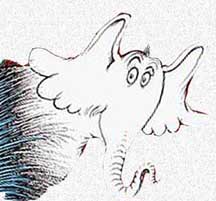 How Do I Prevent These Common Digestive Problems?
How Do I Prevent These Common Digestive Problems?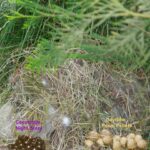
 Does This Orphan Need Veterinary Or Emergency Care?
Does This Orphan Need Veterinary Or Emergency Care?
 What Should I Feed This Baby Cottontail Rabbit?
What Should I Feed This Baby Cottontail Rabbit?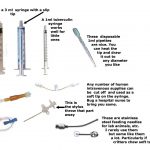
 Stimulating The Baby To Poop And Pee
Stimulating The Baby To Poop And Pee














 Where Should I Release The Bunny?
Where Should I Release The Bunny? I Have Become So Attached To This Rabbit. I Would Hate For It To Be Eatan By Some Predator. Should I Keep This Adorable Creature As My Pet?
I Have Become So Attached To This Rabbit. I Would Hate For It To Be Eatan By Some Predator. Should I Keep This Adorable Creature As My Pet?